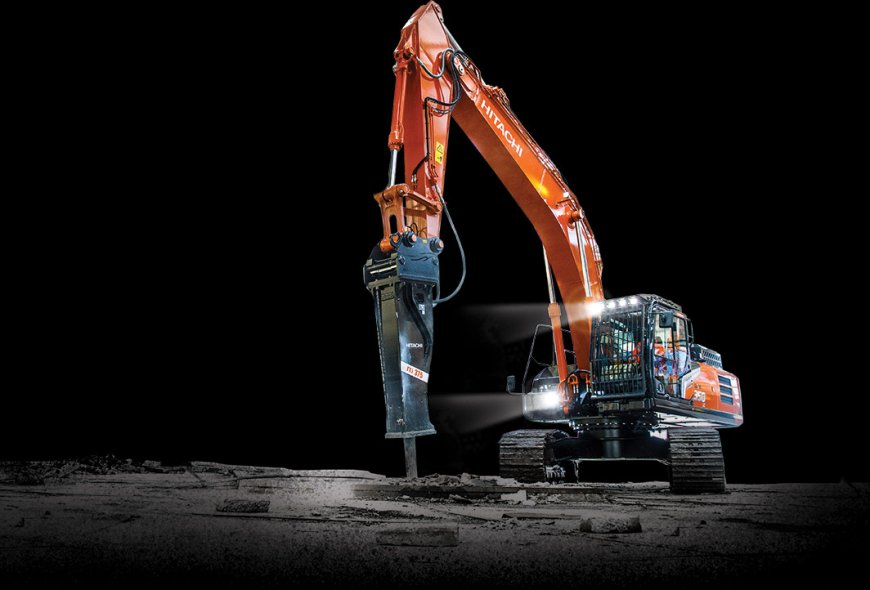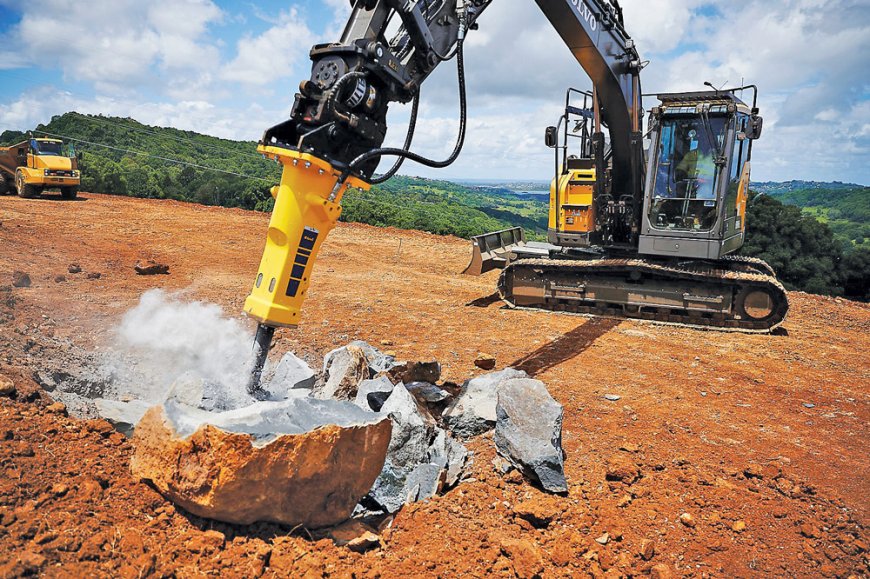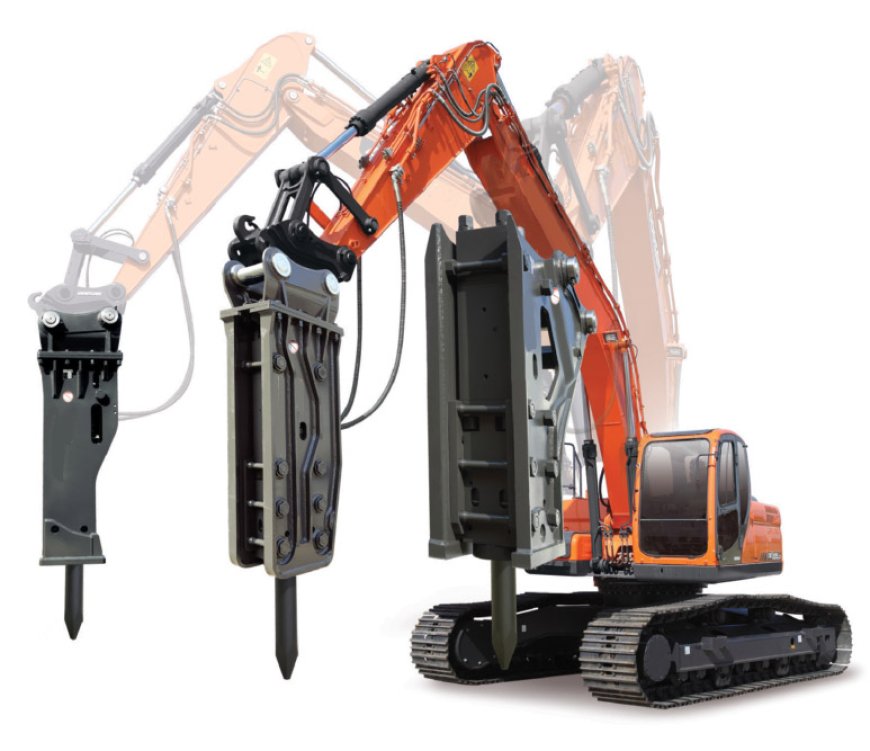Rock Breakers The powerful solution for Tough Operations

Rock breakers have become indispensable in modern construction projects where speed, precision, and efficiency are critical. Whether it is for road construction, mining, demolition, or tunneling, rock breakers offer the ability to break through rock, concrete, and other hard materials with minimal downtime.
Equipment Times dives deep into the evolving role of rock breakers in construction, covering market trends, innovations, challenges, and their future outlook.
The demand for rock breakers in construction has seen significant growth over the last few years. Factors such as increased urbanization, a surge in large-scale infrastructure projects, and stricter timelines have driven the need for reliable, high-performance equipment. The global rock breaker market is expected to grow at a healthy rate, with Asia-Pacific leading the demand, especially in countries like India and China, where infrastructural developments are skyrocketing. With increased investment in roads, metro systems, and urban construction, rock breakers have established themselves as essential tools.
Moreover, the mining industry, which often overlaps with construction operations, has further propelled the market for rock breakers. Mining companies require robust equipment that can withstand heavy usage in challenging environments, and rock breakers have proven to be up to the task.
The Indian Market for Rock Breakers
India’s infrastructure development is undergoing a massive transformation, driven by government-backed projects in road construction, railways, metro systems, and urban development. Alongside this growth, the demand for rock breakers has surged, establishing the equipment as a critical component in construction and mining activities. Rock breakers are extensively used across various applications, from road building to mining and urban demolition projects.

Key Drivers of Growth in the Indian Rock Breaker Market
Infrastructure and Urban Development: The Indian government’s aggressive focus on infrastructure development, such as the Bharatmala Project for highways, Smart Cities Mission, and various metro rail projects, has created a growing demand for high-performance construction equipment. Rock breakers, used in these urban development projects to break rock formations, concrete structures, and hard surfaces, are in high demand due to their efficiency and adaptability to Indian terrain and project needs.
Mining Industry Expansion: India’s mining sector is a significant driver of demand for rock breakers. Mining projects for coal, iron ore, limestone, and other minerals are increasing, and rock breakers are essential tools for breaking large boulders in mines and quarries. The rise in mineral extraction activities across states like Odisha, Jharkhand, and Chhattisgarh directly contributes to the growing need for reliable rock-breaking solutions.
Increased Investments in Road Construction: The Indian government’s road-building initiatives, including the Pradhan Mantri Gram Sadak Yojana (PMGSY) and National Highway Development Project (NHDP), have amplified the need for rock breakers. These machines are integral to cutting through rock formations and preparing surfaces for road construction, particularly in hilly and rocky regions.
Urban Demolition and Recycling: As India’s urban centers expand, old buildings and infrastructure need to be demolished and replaced. Rock breakers play a key role in controlled demolition, making them vital in high-density urban areas where precision and safety are essential. The growing emphasis on urban redevelopment is boosting the market for rock breakers in the demolition sector.

Market Segmentation and Regional Demand
The Indian market for rock breakers is segmented based on application, size, and region.
Application Segmentation: Rock breakers are used primarily in construction, mining, and quarrying sectors. Construction accounts for a large share of the demand due to ongoing infrastructure projects, while the mining and quarrying segments continue to grow due to India’s abundant mineral resources.
Regional Demand: The highest demand for rock breakers is concentrated in the northern, western, and southern regions of India, where large-scale infrastructure and mining activities are taking place. States like Maharashtra, Gujarat, Karnataka, and Tamil Nadu are major consumers of rock breakers due to their thriving construction and mining sectors. The northeastern region is also showing growth, driven by the government’s focus on improving connectivity and infrastructure in hilly and remote areas.
Technological Innovations: Breaking the Mold
The rock breaker industry has seen several technological advancements aimed at improving efficiency, durability, and operator comfort. One major trend is the development of hydraulic breakers, which offer greater power and precision while consuming less fuel. These breakers come with variable blow frequency settings, allowing operators to adjust the impact energy based on the material being worked on. This level of customization boosts efficiency and reduces wear and tear on the machine.
Additionally, manufacturers have focused on increasing the lifespan of rock breaker parts such as chisels, bushings, and wear plates. Materials like high-tensile steel alloys have become standard in ensuring these components last longer in harsh operating conditions. Some companies are also integrating smart monitoring systems into their breakers. These systems provide real-time data on machine health, including hydraulic pressure, impact frequency, and maintenance requirements, helping operators minimize downtime and optimize productivity.
Noise reduction is another focus area for manufacturers, as urban construction sites require machinery to adhere to stringent noise regulations. Innovations in breaker housing and silencing technologies have resulted in quieter rock breakers, making them suitable for use in residential areas or during nighttime operations.
Application Areas: From Construction to Mining
Rock breakers have a wide range of applications across construction and mining. In urban construction, they are primarily used for breaking hard concrete foundations, rock masses, and road surfaces during demolition and road-building activities. Their precision and efficiency make them invaluable in trenching, tunneling, and foundation work where controlled demolition is essential.
In the mining sector, rock breakers are commonly used for primary and secondary breaking of large rocks, facilitating easier transport and further processing. Open-pit mines and quarries often rely on rock breakers to reduce oversized rocks to manageable sizes for crushers, enabling smoother workflows and maximizing equipment efficiency.
Additionally, rock breakers are used in tunneling projects, where they help break through rock layers quickly and safely, ensuring that timelines are met while maintaining operational safety.
Challenges in Operation
While rock breakers are powerful machines, their use comes with specific challenges. One key challenge is ensuring proper maintenance to avoid breakdowns during critical operations. Operators need to be trained in preventive maintenance routines, such as checking hydraulic pressures, greasing moving parts, and monitoring tool wear. Frequent use without maintenance can result in decreased efficiency and costly repairs.
Another challenge is adapting rock breakers to different site conditions. For instance, in areas with extreme temperatures, hydraulic systems can suffer, leading to reduced efficiency. Some manufacturers have developed specialized models for such conditions, incorporating advanced cooling systems to maintain operational integrity.
Furthermore, finding skilled operators remains an industry-wide issue. Operating a rock breaker requires precision, especially when working near structures or in densely populated areas. Many companies have begun offering advanced training programs to help operators better understand how to maximize productivity while minimizing risks.
The Future of Rock Breakers: Toward Automation
The future of rock breakers seems to be headed towards increased automation and integration with smart construction systems. Autonomous rock breakers are already being tested in certain controlled environments, particularly in mining. These systems rely on AI and remote monitoring to perform breaking operations with minimal human intervention, which is crucial for hazardous locations where worker safety is paramount.
Rock breakers have evolved from simple mechanical tools into advanced machines capable of delivering precise, powerful blows that break through the toughest materials. As construction and mining industries continue to push the boundaries of what’s possible, rock breakers are expected to play an even larger role in delivering projects efficiently, safely, and sustainably.
With ongoing advancements in technology and a growing demand for eco-friendly solutions, the rock breaker industry is well-positioned to meet the challenges of tomorrow’s construction and mining landscapes.
What industry has to say

V.G. Sakthikumar, Chairman & Managing Director, Schwing Stetter India, said, “The demand for rock breakers in construction and mining is growing rapidly, driven by infrastructure expansion, urbanization, and increased mining activities worldwide. Factors like the global push for natural resource extraction and large-scale development projects are fueling this demand. We’re seeing the strongest growth in regions like Asia-Pacific, Africa, and the Middle East, where large-scale infrastructure projects and mining operations are booming. The emphasis on environmentally friendly machinery is also contributing to the rise in demand for more efficient and sustainable rock breakers. Our rock breakers are designed for versatility across a wide range of applications, from mining and quarrying to demolition. Key features include high-impact force and precision control, making them effective for breaking through tough rock formations. They offer quick attachment and detachment, enhancing flexibility for different job sites. The advanced hydraulic systems ensure efficient energy use, making them powerful enough to handle the toughest jobs while optimizing performance.”

Peter Royston, Business Line Manager – ATD, Epiroc Mining India, said, “Several innovations in Epiroc’s percussion technology make the breakers more customer and application-friendly. The Intelligent Protection System allows the breaker to start and stop automatically based on hydraulic sensing. This not only eases operation but also prevents idle strokes, saving energy and protecting internal components. Additionally, the HATCON digital accessory can monitor the number of hours the breaker’s impact mechanism is in operation. However, since rock breakers rely on external hydraulic systems for operation, there are limited opportunities to incorporate IoT or AI-driven technology in their design compared to self-driven equipment.”








